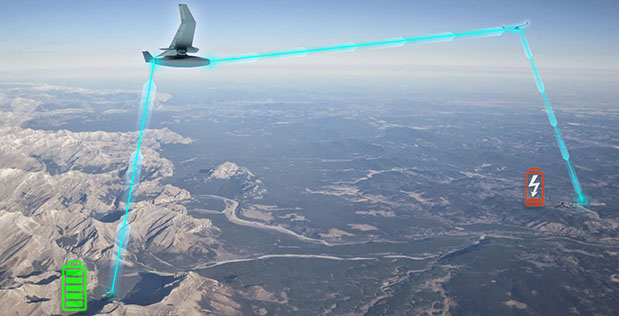Photonics HandbookIndustry News
DARPA Selects Design Teams for Power Beaming Relay Initiative
DARPA has selected three teams, led by RTX Corp., Draper, and BEAM Co., to develop wireless optical power relays for its Persistent Optical Wireless Relay (POWER) program. The program, which will develop energy distribution through airborne wireless power transfer, sets out goals including the demonstration of key components necessary for a resilient, speed-of-light energy network.

Artist’s concept of a wireless energy distribution system. DARPA selected three teams to develop wireless optical power relays for its Persistent Optical Wireless Relay (POWER) program. The program will develop energy distribution through airborne wireless power transfer. Its goals include the demonstration of components necessary for a speed-of-light energy network. Courtesy of DARPA.
To support rapid development, the optical energy relays designed in POWER’s phase one will be demonstrated in pods carried by existing aircraft in the project’s second phase. Additionally, power beaming will enable smaller, less expensive aircraft in the future since fuel storage and engine volume could be dramatically reduced. This will be explored through conceptual designs in phase one. Eventually these new, small, distributed platforms could provide cost-effective aircraft with unlimited range and endurance to support military missions.
Each relay design will be evaluated based on accurate and efficient energy redirection, wavefront correction for high beam quality, and throttleable energy harvesting. In the third and final phase of the program, the relays will be demonstrated through an airborne optical pathway that looks to deliver 10 kW of optical energy to a ground receiver that is 200 km from the ground-source laser.
The first phase will include benchtop demonstrations of critical technologies and is expected to last 20 months with potential for a three-month option of additional risk-reduction efforts. The second phase will involve an open solicitation in early 2025 and will focus on integration of the relay technologies onto an existing platform for a low-power, airborne demonstration.
Published: September 2023